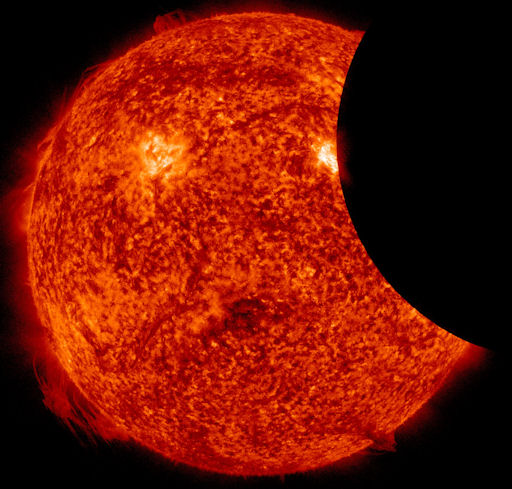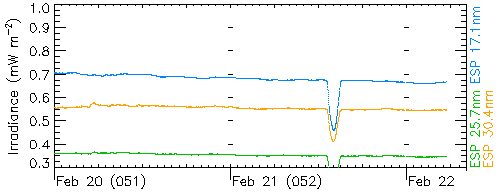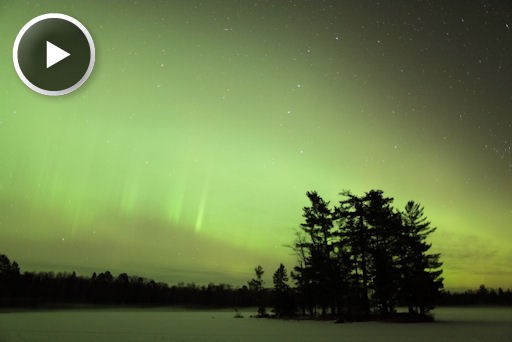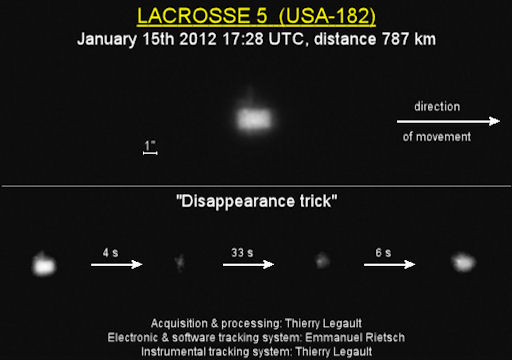SUNSET PLANETS: The brightest planets in the night sky are aligning for a must-see show in late February and March 2012. Start looking tonight. [video] [full story] [New images: #1, #2, #3, #4, #5, #6, #7, #8]
SOLAR ECLIPSE: On Feb. 21st, the new Moon passed in front of the sun, off-center, producing a partial solar eclipse. The only place to see it was from space. NASA's Solar Dynamics Observatory (SDO) sends this picture from geosynchronous orbit approximately 36,000 km above Earth's surface:
Using a bank of 16 megapixel cameras, SDO observed the event at multiple extreme ultraviolet wavelengths. Scan the edge of the Moon in this 171 Å image. The little bumps and irregularities you see are lunar mountains backlit by solar plasma. Also, Steele Hill, SDO's Media Specialist at the Goddard Space Flight Center, has prepared a movie of the event.
Beyond the novelty of observing an eclipse from space, these images have practical value to the SDO science team. The sharp edge of the lunar limb helps researchers measure the in-orbit characteristics of the telescope--e.g., how light diffracts around the telescope's optics and filter support grids. Once these are calibrated, it is possible to correct SDO data for instrumental effects and sharpen the images even more than before.
During the eclipse, the edge of the Moon briefly covered sunspot AR1422, a source of strong ultraviolet emissions. SDO's EVE sensor, which measures the sun's extreme UV output, saw a sharp drop at several wavelengths when the sunspot was behind the Moon:
This should allow scientists to calibrate the spectrum of energy emitted by the sunspot's magnetic canopy--a rare opportunity, indeed.
The next solar eclipse visible from Earth's surface occurs on May 20, 2012: video.
AURORAS OVER THE USA: A solar wind stream hit Earth's magnetic field during the late hours of Saturday, Feb. 18th, sparking a G1-class geomagnetic storm. Usually, auroras produced by such a mild storm would be confined to Arctic latitudes. Not this time. Northern Lights spilled across the Canadian border into US states such as Wisconsin, Michigan, Iowa, North Dakota, Nebraska and Minnesota. Bob Conzemius video-recorded the display from the Chippewa National Forest north of Grand Rapids, MN:
"It was fun watching the auroras illuminate the fog and snow on the lake while listening to barred owls calling," says Conzemius. "I may have heard a couple wolves howling in the distance, too."
In Nebraska "I saw auroras on and off for approximately 2 hours from around 9pm to 11pm local time," reports Chris Allington of Crofton, NE. "There was a brief spell where color was visible to the eye with rays and bands." Allington stitched together a series of 20s exposures to create this movie.
At the height of the display, researchers at the Poker Flats Research Range outside of Fairbanks, Alaska, launched a suborbital rocket to investigate how auroras affect GPS systems. Several photographers in the area caught the rocket flying into the Northern Lights.
The surprising display might have been amplified by the action of a co-rotating interaction region or "CIR." CIRs are transition zones between fast and slow solar wind streams. Solar wind plasma piles up in these regions, producing density gradients and shock waves that do a good job of sparking auroras. Local solar wind data suggest that Earth moved through a CIR around 1500 UT on Feb. 18th.
February 2012 Aurora Gallery
[previous Februaries: 2011, 2010, 2009, 2008, 2007, 2006, 2004, 2003, 2002]
SPY-SAT DISAPPEARING TRICK: US spy satellite Lacrosse 5 occasionally confounds observers by disapppearing: In a matter of seconds, it can fade more than three astronomical magnitudes. Is this a deliberate form of stealth? Most experts think not, but no one outside of classified circles knows for sure what is going on.
To investigate, French astrophotographer Thierry Legault used his satellite-tracking telescope to photograph Lacrosse 5 as it sailed 490 miles above Paris on Jan. 15, 2012, and he caught the spysat in the act of disappearing:
"During the passage, the brightness of the satellite decreased by 10 times in only 4 seconds (a loss of 2.5 magnitudes)," describes Legault. "After 33 seconds of [dark flight] it regained its original brightness. Lacrosse 5 often shows this very singular behaviour, which is called by other observers (especially Marco Langbroek) the 'disappearing trick.'"
Other Lacrosse satellites do not perform the same trick, at least not to this extent, suggesting that the design of Lacrosse 5 differs from its predecessors. The fade is likely caused by some sort of self-shadowing--e.g., maybe some part of the spacecraft such as its solar panels casts a shadow over the main body when the spysat changes attitude.
Even Legault's fine images do not reveal the answer. "The cause of the disappearing trick, as well as the precise shape of the satellite, remain unknown."
Readers, would you like to try catching the tricks of Lacrosse 5? Check SpaceWeather's Simple Satellite Tracker and Flybys App for local flyby times.

Solar wind
speed: 523.2 km/sec
density: 1.6 protons/cm3
explanation | more data
Updated: Today at 1346 UT
X-ray Solar Flares
6-hr max: B2 0915 UT Feb22
24-hr: B3 0641 UT Feb22
explanation | more data
Updated: Today at: 1300 UT
![]()
Daily Sun: 22 Feb 12
There is a slight (10%) chance of M-class solar flares today from sunspot AR1422. Credit: SDO/HMI
![]()
Sunspot number: 61
What is the sunspot number?
Updated 21 Feb 2012
Spotless Days
Current Stretch: 0 days
2012 total: 0 days (0%)
2011 total: 2 days (<1%)
2010 total: 51 days (14%)
2009 total: 260 days (71%)
Since 2004: 821 days
Typical Solar Min: 486 days
Updated 21 Feb 2012
The Radio Sun
10.7 cm flux: 103 sfu
explanation | more data
Updated 21 Feb 2012
![]()
Current Auroral Oval:
Switch to: Europe, USA, New Zealand, Antarctica
Credit: NOAA/POES
![]()
Planetary K-index
Now: Kp= 2 quiet
24-hr max: Kp= 3 quiet
explanation | more data
Interplanetary Mag. Field
Btotal: 8.1 nT
Bz: 3.5 nT north
explanation | more data
Updated: Today at 1347 UT
![]()
Coronal Holes: 22 Feb 12
A solar wind stream flowing from the indicated coronal hole should reach Earth on Feb. 25-26. Credit: SDO/AIA.
![]()
|







